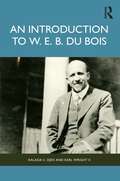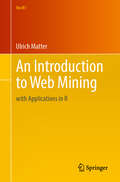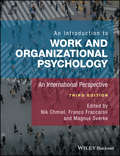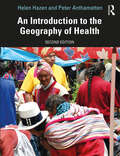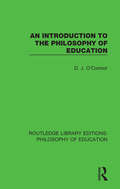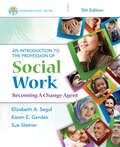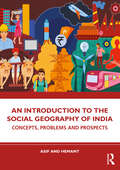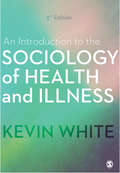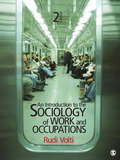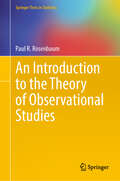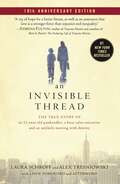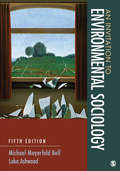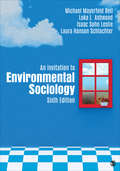- Table View
- List View
An Introduction to Universal Artificial Intelligence (Chapman & Hall/CRC Artificial Intelligence and Robotics Series)
by Marcus Hutter David Quarel Elliot CattAn Introduction to Universal Artificial Intelligence provides the formal underpinning of what it means for an agent to act intelligently in an unknown environment. First presented in Universal Algorithmic Intelligence (Hutter, 2000), UAI offers a framework in which virtually all AI problems can be formulated, and a theory of how to solve them. UAI unifies ideas from sequential decision theory, Bayesian inference, and algorithmic information theory to construct AIXI, an optimal reinforcement learning agent that learns to act optimally in unknown environments. AIXI is the theoretical gold standard for intelligent behavior.The book covers both the theoretical and practical aspects of UAI. Bayesian updating can be done efficiently with context tree weighting, and planning can be approximated by sampling with Monte Carlo tree search. It provides algorithms for the reader to implement, and experimental results to compare against. These algorithms are used to approximate AIXI. The book ends with a philosophical discussion of Artificial General Intelligence: Can super-intelligent agents even be constructed? Is it inevitable that they will be constructed, and what are the potential consequences?This text is suitable for late undergraduate students. It provides an extensive chapter to fill in the required mathematics, probability, information, and computability theory background.
An Introduction to Urban Geography (Routledge Library Editions: Urban Studies #22)
by John R. ShortThis book, first published in 1984, is an attempt to make students aware of the variety in the urban condition and to introduce them to some of the relationships operating between space and society. From the broad aim of seeking to show the relationship between urbanism and society flows a number of sub-themes, including the importance of cross-cultural comparisons and contrasts, re-distributional consequences and the role of government. This book will be of interest to first- and second-year students of urban studies and human geography.
An Introduction to Using Mapping Sentences
by Paul M. Hackett Katelyn LustigThis book acts as an introductory guide to understanding and using the mapping sentence as a tool in social science and humanities research. The book fills the need for a concise text that simply instructs how and when to use a mapping sentence and provides practical examples. Mapping sentences are a major research component and tool of facet theory. The book begins by covering the background to mapping sentence, including the philosophy and theory underpinning it. The following chapter discuss what mapping sentence is, what different kinds of mapping sentences exist, and knowing when and which to use it in a given situation. The book then moves into describing how to write a mapping sentence and how to analyse the information gained from mapping sentence research. It ends with a consideration of the future developments of mapping sentences and their applications across the social sciences and humanities, including in particular psychology, marketing, behavioural biology, art and health.
An Introduction to W. E. B. Du Bois
by Earl Wright II Kalasia S. OjehAn Introduction to W. E. B. Du Bois examines the historical contributions to social science and the continuing relevance of the work of W. E. B. Du Bois in an accessible manner. The first volume of its kind, it places the theories of Du Bois in context, showing how the socio‑racial environment in which he grew up and came of age influenced the development of his thought. In addition to covering well‑known concepts such as double consciousness, the veil, and religious fatalism, the authors discuss Du Bois’ uncoined theories emanating from the Atlanta University Studies, as well as his contributions to the development of Black sociology and research methodology. A groundbreaking contextualization and summary of the importance of Du Bois’ work to sociology and sociological theory, this book constitutes a much‑needed resource for scholars and students seeking to understand this scholar’s significance to the social sciences beyond the elementary level.
An Introduction to Web Mining: with Applications in R (Use R!)
by Ulrich MatterThis book is devoted to the art and science of web mining — showing how the world's largest information source can be turned into structured, research-ready data. Drawing on many years of teaching graduate courses on Web Mining and on numerous large-scale research projects in web mining contexts, the author provides clear explanations of key web technologies combined with hands-on R tutorials that work in the real world — and keep working as the web evolves. Through the book, readers will learn how to - scrape static and dynamic/JavaScript-heavy websites - use web APIs for structured data extraction from web sources - build fault-tolerant crawlers and cloud-based scraping pipelines - navigate CAPTCHAs, rate limits, and authentication hurdles - integrate AI-driven tools to speed up every stage of the workflow - apply ethical, legal, and scientific guidelines to their web mining activities Part I explains why web data matters and leads the reader through a first &“hello-scrape&” in R while introducing HTML, HTTP, and CSS. Part II explores how the modern web works and shows, step by step, how to move from scraping static pages to collecting data from APIs and JavaScript-driven sites. Part III focuses on scaling up: building reliable crawlers, dealing with log-ins and CAPTCHAs, using cloud resources, and adding AI helpers. Part IV looks at ethical, legal, and research standards, offering checklists and case studies, enabling the reader to make responsible choices. Together, these parts give a clear path from small experiments to large-scale projects. This valuable guide is written for a wide readership — from graduate students taking their first steps in data science to seasoned researchers and analysts in economics, social science, business, and public policy. It will be a lasting reference for anyone with an interest in extracting insight from the web — whether working in academia, industry, or the public sector.
An Introduction to Work and Organizational Psychology: An International Perspective
by Franco Fraccaroli Magnus Sverke Nik ChmielThis fully updated edition of a best-selling textbook provides the most comprehensive introduction to issues in work and organizational psychology with an international perspective; reflecting current advancements in the workplace, the book brings together the expertise of leading thinkers and practitioners. Fully updated third edition of the best-selling textbook on work and organizational psychology now with an international perspective Presents a solid foundation on a range of core topics including working with technology, the impact on employees when organizations change, and maintaining the work-life balance Updated throughout to include recently emerging themes and current views in the field Includes five new case studies covering age management, diversity at the top, resilience development, respect at work and a strategic approach to improving wellbeing in the workplace Provides instructor and student support includes key studies, research close-ups, discussion points and five extensive case studies
An Introduction to the Geography of Health
by Peter Anthamatten Helen HazenIn the second edition of An Introduction to the Geography of Health, Hazen and Anthamatten explore the ways in which geographic ideas and approaches can inform our understanding of health. The book’s focus on a broad range of physical and social factors that drive health in places and spaces offers students and scholars an important holistic perspective on the study of health in the modern era. In this edition, the authors have restructured the book to emphasize the theoretical significance of ecological and social approaches to health. Spatial methods are now reinforced throughout the book and other qualitative and quantitative methods are discussed in greater depth. Data and examples are used extensively to illustrate key points and have been updated throughout, including several new extended case studies such as water contamination in Flint Michigan, microplastics pollution, West Africa’s Ebola crisis, and the Zika epidemic. The book contains over one hundred figures, including new and updated maps, data graphics, and photos. The book is designed to be used as the core text for a health geography course for undergraduate and lower-level graduate students, and is relevant to students of biology, medicine, entomology, social science, urban planning, and public health.
An Introduction to the History of Educational Theories (Routledge Revivals)
by Oscar BrowningAn Introduction to the History of Educational Theories, first published in 1881, offers a comprehensive overview of the most notable approaches to education throughout Western history, from Athens and Rome to the Victorian public school. Exploring not only the still famous theories of Plato and Aristotle, this work also touches on techniques in education which are either no longer prevalent – Roman Oratory, the Jesuits – or in some cases were never widely adopted or appreciated: John Milton, for example. This title will be of value to those intrigued by the potential of past attitudes for present-day application, as well as to those unconvinced by contemporary approaches.
An Introduction to the History of Human Development and Family Science
by Andrea L. RoachThis comprehensive textbook offers an interdisciplinary introduction to the history of human development and family science. It provides insights from home economics, sociology and psychology to explain and analyze how the field was established and how it is developing and showcases the contribution of its unique transdisciplinary nature.Expert authors cover key topics and highlight historical contributions from women, scholars of color and LGBTQIA scholars; they emphasize and incorporate research that cuts across cultures; and examine current human development and family science trends in research and careers in their chosen fields. Subjects and issues covered include historical and contemporary studies of child development, adolescent development and young adulthood, adulthood and aging, family science, marriage formation and maintenance, parenthood, divorce, the role of grandparents and sibling relationships.Exploring how human development and family science can be used as a springboard into careers such as marriage and family therapy, social work, case management, teaching and research, this essential textbook is for all students of human development and family science.
An Introduction to the Philosophy of Education (Routledge Library Editions: Philosophy of Education #14)
by D. J. O'ConnorEducation, like every other important branch of knowledge, has its underlying philosophical problems. It is these problems and the attempts to solve them which together make up the philosophy of education. This book, first published in 1957, provides a simple explanation and illustration of what philosophy can (and cannot) do for educational thinking. This title will be of interest to students of the philosophy of education.
An Introduction to the Philosophy of Law (Storrs Lecture)
by Roscoe Pound Marshall. L DeRosaIn An Introduction to the Philosophy of Law, Roscoe Pound shows how philosophy has been a powerful instrument throughout the history of law. He examines what philosophy has done for some of the chief problems of the science of law and how it is possible to look at those problems philosophically without treating them in terms of a particular time period. The function of legal philosophy, writes Pound, is to rationally formulate a general theory of law which conforms to the interests, the general security first and foremost, of society. Marshall DeRosa writes in his new introduction that in the light of twentieth-century judicial politics, Roscoe Pound's philosophy of law has prevailed to a significant extent. This book's relevance to appreciating the development of the American legal system in all its complexities - including liability law, contract law, and property law - is in itself notable. But, in terms of understanding the twentieth-century development of the American rule of law, An Introduction to the Philosophy of Law is indispensable. It will make an invaluable addition to the personal libraries of legal theorists, philosophers, political scientists, and historians of American law.
An Introduction to the Policy Process
by Thomas A BirklandThe fourth edition of this widely-used text relates theory to practice in the public policy process. In a clear, conversational style, author Tom Birkland conveys the best current thinking on the policy process with an emphasis on accessibility and synthesis. This new edition has been reorganized to better explain the role of policy analysis in the policy process. New to this edition: * A new section on the role of policy analysis and policy analysts in the policy process. * A revised and updated chapter surveying the social, economic, and demographic trends that are transforming the policy environment. * Fully updated references to help the advanced reader locate the most important theoretical literature in policy process studies. * New illustrations and an improved layout to clarify key ideas and stimulate classroom discussion. The book makes generous use of visual aids and examples that link policy theory to the concrete experience of practitioners. It includes chapter-at-a-glance outlines, definitions of key terms, provocative review questions, recommended reading, and online materials for professors and students.
An Introduction to the Profession of Social Work: Becoming A Change Agent (Empowerment Series)
by Elizabeth A. Segal Sue Steiner Karen E. GerdesSegal, Gerdes, and Steiner's AN INTRODUCTION TO THE PROFESSION OF SOCIAL WORK introduces readers to the social work profession and describes the role of social worker in the social welfare system. Through case studies, personal stories, and exercises, this social work text helps readers apply the concepts and truly understand what it means to be a social worker. Part of the Brooks/Cole Empowerment Series, the fourth edition is completely up to date and thoroughly integrates the core competencies and recommended practice behaviors outlined in the most recent Educational Policy and Accreditation Standards (EPAS) set by the Council on Social Work Education (CSWE).
An Introduction to the Social Geography of India: Concepts, Problems and Prospects
by Asif Ali HemantThis book discusses the significance of social geography, a multidimensional sub-discipline of georgraphy encompassing social health, social security and social ethos. It presents the socio-spatial dynamics of the population in India through an understanding of the various issues related to migration, urbanisation, unemployment, poverty and public health. With a thorough analysis of various social indicators relating to health, education, income and employment, the volume presents a detailed picture of the social geography of India. It discusses in detail, The origin, nature and scope of social geography, its relations with other social sciences and applications The nature and importance of social well-being along with welfare geography and the role of welfare state in ensuring social well-being The population of India and its attributes The status and spatial patterns of various social indicators relating to health, education and income and employment The composite indices which aggregate several social indicators such as the Human Development Index, Multidimensional Poverty Index and Sustainable Developmental Goals Index in the context of India. This comprehensive book will be useful for students, researchers and teachers of social geography, human geography, population geography, demography and sociology. The book can also be used by students preparing for exams like civil services, UPSC, PSC and other competitive exams.
An Introduction to the Sociology of Health and Illness
by Kevin WhiteThe bestselling An Introduction to the Sociology of Health and Illness has long been the go-to text for students looking for a clear, engaging and theoretically informed introduction to this dynamic topic. Written with a truly sociological and critical perspective, and thoroughly updated to include the latest cutting-edge thinking in the area, the new edition is packed with new empirical examples. Incorporating helpful learning features including chapter overviews, boxed cases, summaries and further reading, this book is a stimulating and thought-provoking essential text for students in health, nursing and sociology schools.
An Introduction to the Sociology of Health and Illness
by Kevin White"An accessible and highly readable introduction to the Sociology of Health and Illness through the inclusion of key theorists, concepts, and theories, with reference to contemporary health concerns and recent relevant research." - Kylie Baldwin, De Montfort University "Guides us through the many reasons for the centrality of health, showing clearly that health and illness are the products not just of our biology but of the society into which we are born...an authoritative analysis of the social nature of health." - Ray Fitzpatrick, University of Oxford This bestselling text introduces students to the core principles of the sociology of health, demonstrating the relationship between social structures and the production and distribution of health and disease in modern society. Written with a truly sociological and critical perspective, the book tackles themes such as class, gender and ethnicity, and engages with a range of theories and theorists, including Foucault, Fleck, Parsons, Weber, and Kuhn. The third edition has been thoroughly updated to include the latest cutting-edge thinking in the area, with new empirical examples, updated references, and new sections on ′Thought Styles after Fleck’, and ‘Transformations of the Medical Profession.′ It also uses helpful learning features including chapter overviews, case studies, summaries and further reading suggestions, to provide stimulating and thought-provoking exercises for students in health, nursing and sociology schools.
An Introduction to the Sociology of Law
by Nicholas Sergeyevitch TimasheffThe exiled Russian sociologist and legal scholar Nicholas S. Timasheff's place in the forefront of the sociology of law was established with the publication, in 1939, of An Introduction to the Sociology of Law. His magnum opus articulates a systematic legal sociology. The book's title is misleading, giving the false impression that the volume is merely a textbook intended for classroom use. It is much more than this. An Introduction to the Sociology of Law is a sophisticated treatise that explains, precisely and methodically, the law as a social force. It makes two fundamental points: law can, indeed must, be studied by sociology, and law is a combination of socio-ethical and imperative coordination of human behavior.
An Introduction to the Sociology of Work and Occupations (2nd Edition)
by Rudi VoltiThe Sociology of Work and Occupations, Second Edition connects work and occupations to the key subjects of sociological inquiry: social and technological change, race, ethnicity, gender, social class, education, social networks, and modes of organization. In 15 chapters, Rudi Volti succinctly but comprehensively covers the changes in the world of work, encompassing everything from gathering and hunting to working in today's Information Age. This book introduces students to a highly relevant analysis of society today. In this new and updated edition, globalization and technology are each given their own chapter and discussed in great depth.
An Introduction to the Study of Social Administration (Routledge Library Editions: Social Administration & Social Policy)
by David C. MarshOriginally published in 1965, this introductory textbook provides the student with an outline of the subject matter of Social Administration. It deals with the growth of this discipline of study, its inter-relatedness with the other social sciences, and examines the historical development and structure of the social services in the 20th Century. The book discusses the complexity of the study of the study of the formation and implementation of social policy in the United Kingdom and will be of interest to those in the areas of the history of social policy and the welfare state.
An Introduction to the Theory of Observational Studies (Springer Texts in Statistics)
by Paul R. RosenbaumThis book is an introduction to the theory of causal inference in observational studies. An observational study draws inferences about the effects caused by treatments or preventable exposures when randomized experimentation is unethical or infeasible. An observational study is distinguished from an experiment by the problems that follow from the absence of randomized assignment of individuals to treatments. Observational studies are common in most fields that study the effects of treatments or policies on people, including public health and epidemiology, economics and public policy, medicine and clinical psychology, and criminology and empirical legal studies. After Part I reviews causal inference in randomized experiments, the twelve short chapters in Parts II, III and IV introduce modern topics: the propensity score, ignorable treatment assignment, the principal unobserved covariate, algorithms for optimal matching, randomized reassignment techniques for appraising the covariate balance achieved by matching, covariance adjustment, sensitivity analysis, design sensitivity, ways to design an observational study to be insensitive to larger unmeasured biases, the large sample efficiency of a sensitivity analysis, quasi-experimental devices that provide observable information about unmeasured biases, evidence factors and complementary analyses to address unmeasured biases. The book is accessible to anyone who has completed an undergraduate course in mathematical statistics. The subject is developed with the aid of two simple empirical examples concerning the health benefits or harms caused by consuming alcohol. The data for these examples and their reanalyses are freely available in an R package, iTOS, associated with Introduction to the Theory of Observational Studies.
An Investigation of Women's and Men's Perceptions and Meanings Associated with Food Risks
by Andrea BiebersteinConcern about food risks is widespread. Consumers, however, are found to differ in terms of how they evaluate these risks. One of the most prominent findings in this regard is the differences between women and men. Many studies report that men are less worried about environmental and technological risks than women, which is also the case for food risks. At the same time it is criticized that these differences are often exaggerated, similarities overlooked, and systematic investigations are lacking. Andrea Bieberstein gives a comprehensive overview of theoretical approaches to risk perception and empirical work that has been conducted in the field of risk perception research. Furthermore, she provides a systematic investigation of how food risks are constructed for women and men by uncovering the meanings in terms of associations, feelings, and values that they attach to various food risks. This allows a deeper understanding of the gender differences in risk perception in terms of their relevance and meaning.
An Invisible Thread: The True Story of an 11-Year-Old Panhandler, a Busy Sales Executive, and an Unlikely Meeting with Destiny (Current Practices in Ophthalmology)
by Valerie Salembier Alex Tresniowski Laura SchroffAn Invisible Thread tells of the life-long friendship between a busy sales executive and a disadvantaged young boy, and how both of their lives were changed by what began as one small gesture of kindness.When Laura Schroff brushed by a young panhandler on a New York City corner one rainy afternoon, something made her stop and turn back. She took the boy to lunch at the McDonald's across the street that day. And she continued to go back, again and again for the next four years until both their lives had changed dramatically. Nearly thirty years later, that young boy, Maurice, is married and has his own family. Now he works to change the lives of disadvantaged kids, just like the boy he used to be. An Invisible Thread is the true story of the bond between a harried sales executive and an eleven-year-old boy who seemed destined for a life of poverty. It is the heartwarming story of a friendship that has spanned three decades and brought meaning to an over-scheduled professional and hope to a hungry and desperate boy living on the streets.
An Invitation to Environmental Sociology
by Michael Mayerfeld Bell Ms Loka L. Ashwood“This is not only the best environmental sociology text I’ve used, but it is the best text of any type I’ve used in college-level teaching.” –Dr. Cliff Brown, University of New Hampshire Join author Mike Bell and new co-author Loka Ashwood as they explore “the biggest community of all” and bring out the sociology of environmental possibility. The highly-anticipated Fifth Edition of An Invitation to Environmental Sociology delves into this rapidly changing and growing field in a clear and artful manner. Written in a lively, engaging style, this book explores the broad range of topics in environmental sociology with a personal passion rarely seen in sociology books. The Fifth Edition contains new chapters entitled “Money and Markets,” “Technology and Science,” and “Living in An Ecological Society.” In addition, this edition brings in fresh material on extraction between core and periphery countries, the industrialization of agriculture, the hazards of fossil fuel production, environmental security, and making environmentalism normal.
An Invitation to Environmental Sociology
by Michael Mayerfeld Bell Ms Loka L. Ashwood“This is not only the best environmental sociology text I’ve used, but it is the best text of any type I’ve used in college-level teaching.” –Dr. Cliff Brown, University of New Hampshire Join author Mike Bell and new co-author Loka Ashwood as they explore “the biggest community of all” and bring out the sociology of environmental possibility. The highly-anticipated Fifth Edition of An Invitation to Environmental Sociology delves into this rapidly changing and growing field in a clear and artful manner. Written in a lively, engaging style, this book explores the broad range of topics in environmental sociology with a personal passion rarely seen in sociology books. The Fifth Edition contains new chapters entitled “Money and Markets,” “Technology and Science,” and “Living in An Ecological Society.” In addition, this edition brings in fresh material on extraction between core and periphery countries, the industrialization of agriculture, the hazards of fossil fuel production, environmental security, and making environmentalism normal.
An Invitation to Environmental Sociology: Bell, An Invitation To Environmental Sociology 3e + Newman, Sociology Brief (Sociology For A New Century Ser.)
by Michael Mayerfeld Bell Isaac Leslie Laura Hanson Schlachter Loka L. AshwoodIf there were ever a time for environmental sociology, it is now. As COVID-19 is spreading across our communities, our countries, our world, we have all become too familiar with maintaining that awful term of "social distance." Yet there can be no true distance from that which is always with us and within us: our social ecology An Invitation to Environmental Sociology invites students to delve into this rapidly changing field. Written in a lively, engaging style, the authors cover a broad range of topics in environmental sociology with a personal passion rarely seen in sociology texts. The book′s unique organization explores three different kinds of questions about interactions between humans and the natural world: the material, the ideal, and the practical. The Sixth Edition of this bestseller comprises 12 chapters instead of 13, making it easier to fit into the normal rhythm of a course. But the result is also an edition that is up-to-date and enriched with much newer material, while continuing to use an inviting tone that the title promises. Included with this title: The password-protected Instructor Resource Site (formally known as SAGE Edge) offers access to all text-specific resources, including a test bank and editable, chapter-specific PowerPoint® slides.



